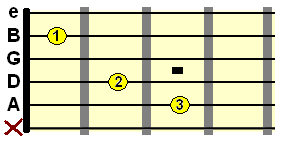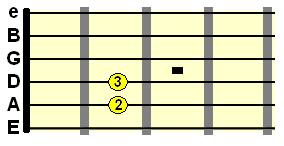Home
> Progressions
> Basics
The chords we're about to look at have been used in some of the most loved rock and pop music out there. Songwriting doesn't have to be complex.
Simply having a "hook" or a memorable/catchy melody is all it needs. That, and good vocals of course, but we're focussing on guitar here!
Let's begin with some basic chord progression theory...
I won't get too in depth with the theory behind this right now as it's covered in its own lessons, but the easiest way to understand key is to pick a major or minor chord and begin your song on that chord. Later we'll build relationships that naturally reaffirm this key center.

Starting on a major chord, such as C major, will most often set the mood for a happy, positive, upbeat progression...

Whereas starting on a minor chord, such as E minor below, will typically set the mood for a rather melancholic, downbeat or tragic piece...
In music theory, we call this chord the tonic, often abbreviated to the numeral I. More on this another time!
This major/minor difference is important to get an ear for. However, I should point out that it's easy to become dogmatic over how major and minor, both chords and keys, differ in the emotional response they yield. It's clearly one of those "meaning of life" questions that cannot be satisfactorily concluded as "minor = sad, major = happy".
The important thing, from an objective point of view, is that the distinction between major and minor key progressions is clear in your mind. It will become clearer as we progress...
Eventually, you'll want to return back home! This is called resolution.
Now, there are certain movements between the tonic chord and other chords that naturally work to reinforce that key center. Below is a table, using chord fingerings from the basic guitar chords series, showing you these chord pairings. The second chord is known as the V (5) chord. Don't worry about what that means now, just listen to how it naturally works with its tonic chord.
You can probably hear how "natural" these movements sound, and that's why this I - V relationship has been used in music for centuries, from classical through to pop and rock music.
Obviously, you don't have to use this movement at all, but it's there if you need it, and the more you play the more you will get a sense of when it's "right" to use it. That's intuition!
There are other natural movements we can use between our tonic major chord and other chords (we'll cover minor key later).
Such as the Tonic - IV relationship...
Again, just like the I - V relationship, these chords are naturally related (more on why they are another time). Get to know both relationships as both offer different sounds.
Just from what we've learned so far, we can create simple I - IV - V (1 4 5) chord progressions.
For example...
A major - D major - E major - D major - click to hear
G major - D major - C major - click to hear
As we'll learn in a later part, you don't always have to start the progression with the tonic chord.
Let's just look at a couple more important relationships, the first involving what is known as the ii chord, which is naturally a minor chord. The ii chord is a perfect example of how minor chords can work within a major key progression, as part of the journey...
And finally, let's look at the I - vi relationship. The vi chord is naturally a minor chord (hence the lower case numeral). When using open chord fingerings, there are only two tonics we can use for this relationship...
So, by keeping all these relationships intact with the tonic chord you choose, we can create very simple progressions (although some of the most loved music out there uses these simple relationships). You don't have to use all four chords, and we'll look more at song structure in a later part.
By using these relationships in all, or part of your progressions, you naturally reinforce that tonic "home" chord.
Here are some 3 and 4 chord ideas to get you started.
C major - A minor - D minor - G major - click to hear
D major - A major - E minor - click to hear
G major - C major - E minor - D major - click to hear
Keep playing around with your own sequences, using as many combinations as you can come up with. We've only just begun!
More Basic Guitar Chord Progressions
Basic Guitar Chord Progressions
This is the first lesson in the basic guitar chord progressions series. It'll show you how easy it is to write meaningful chord progressions using those basic guitar chords (also known as open position chords) you learn as a beginner, so make sure you've been through those lessons first.The chords we're about to look at have been used in some of the most loved rock and pop music out there. Songwriting doesn't have to be complex.
Simply having a "hook" or a memorable/catchy melody is all it needs. That, and good vocals of course, but we're focussing on guitar here!
Let's begin with some basic chord progression theory...
Finding the key of your chord progression
When musicians talk about key, they are most often referring to the chord that your song is built around - a musical center of gravity. A chord we can call "home".I won't get too in depth with the theory behind this right now as it's covered in its own lessons, but the easiest way to understand key is to pick a major or minor chord and begin your song on that chord. Later we'll build relationships that naturally reaffirm this key center.

Starting on a major chord, such as C major, will most often set the mood for a happy, positive, upbeat progression...

Whereas starting on a minor chord, such as E minor below, will typically set the mood for a rather melancholic, downbeat or tragic piece...
In music theory, we call this chord the tonic, often abbreviated to the numeral I. More on this another time!
This major/minor difference is important to get an ear for. However, I should point out that it's easy to become dogmatic over how major and minor, both chords and keys, differ in the emotional response they yield. It's clearly one of those "meaning of life" questions that cannot be satisfactorily concluded as "minor = sad, major = happy".
The important thing, from an objective point of view, is that the distinction between major and minor key progressions is clear in your mind. It will become clearer as we progress...
Building basic chord progressions using natural relationships
A chord progression is simply a sequence of chords. Most songs make use of several chord changes and this is what gives the listener the feeling of being taken on a journey. Since our tonic chord is "home", the other chords can be seen as the journey "away from home".Eventually, you'll want to return back home! This is called resolution.
Now, there are certain movements between the tonic chord and other chords that naturally work to reinforce that key center. Below is a table, using chord fingerings from the basic guitar chords series, showing you these chord pairings. The second chord is known as the V (5) chord. Don't worry about what that means now, just listen to how it naturally works with its tonic chord.
| Tonic (I) | C major | G major | D major | A major |
| V Chord | G major | D major | A major | E major |
You can probably hear how "natural" these movements sound, and that's why this I - V relationship has been used in music for centuries, from classical through to pop and rock music.
Obviously, you don't have to use this movement at all, but it's there if you need it, and the more you play the more you will get a sense of when it's "right" to use it. That's intuition!
There are other natural movements we can use between our tonic major chord and other chords (we'll cover minor key later).
Such as the Tonic - IV relationship...
| Tonic (I) | E major | A major | D major | G major |
| IV Chord | A major | D major | G major | C major |
Again, just like the I - V relationship, these chords are naturally related (more on why they are another time). Get to know both relationships as both offer different sounds.
Just from what we've learned so far, we can create simple I - IV - V (1 4 5) chord progressions.
For example...
A major - D major - E major - D major - click to hear
G major - D major - C major - click to hear
As we'll learn in a later part, you don't always have to start the progression with the tonic chord.
Let's just look at a couple more important relationships, the first involving what is known as the ii chord, which is naturally a minor chord. The ii chord is a perfect example of how minor chords can work within a major key progression, as part of the journey...
| Tonic (I) | D major | C major | G major |
| ii Chord | E minor | D minor | A minor |
And finally, let's look at the I - vi relationship. The vi chord is naturally a minor chord (hence the lower case numeral). When using open chord fingerings, there are only two tonics we can use for this relationship...
| Tonic (I) | C major | G major |
| vi Chord | A minor | E minor |
So, by keeping all these relationships intact with the tonic chord you choose, we can create very simple progressions (although some of the most loved music out there uses these simple relationships). You don't have to use all four chords, and we'll look more at song structure in a later part.
By using these relationships in all, or part of your progressions, you naturally reinforce that tonic "home" chord.
Here are some 3 and 4 chord ideas to get you started.
C major - A minor - D minor - G major - click to hear
D major - A major - E minor - click to hear
G major - C major - E minor - D major - click to hear
Keep playing around with your own sequences, using as many combinations as you can come up with. We've only just begun!
Was this lesson helpful? Please let others know, cheers...
| |
Tweet |
Related
More Basic Guitar Chord Progressions








